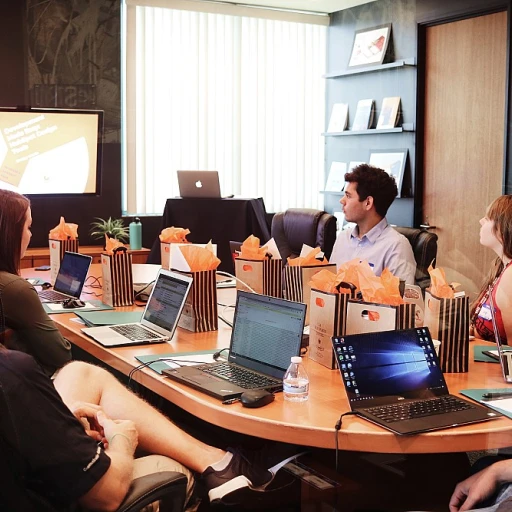
Understanding Workforce Intelligence
Decoding the Value of Workforce Insights
Understanding workforce intelligence involves exploring the blend of data-driven analytics and strategic workforce management. This concept plays a pivotal role in aligning employee skills with organizational goals. Workforce intelligence is not a fleeting trend; rather, it's an evolving idea, deeply rooted in a data-rich environment. Through its application, organizations can gain actionable insights to enhance productivity and improve talent management decisions. Harnessing the power of workforce analytics enables companies to assess their employee performance more thoroughly. By scoping out where improvements are needed, management can tailor reskilling programs effectively. Workforce analytics also helps organizations identify skill gaps — a crucial step in workforce planning. Once these gaps are highlighted, the real-time data allows for swift action, bridging the skills deficit efficiently. Organizations across various sectors, including Southeast Michigan's bustling corporate scene and community colleges like those in the Michigan Works network, are leveraging these insights to boost employee engagement. This is important as engaged employees are key players in a high-performing team. Consequently, this approach sets the stage for informed decision-making, driven by sophisticated management software that provides timely and precise data analytics. Incorporating intelligence into workforce planning empowers businesses to make calculated decisions. It offers management a clearer view of their current workforce performance and helps set tangible goals for future improvements. As businesses wrestle with rapidly changing skill requirements, having a clear comprehension of workforce intelligence helps them stay competitive. By investing time in understanding this complex landscape, companies can boost their overall business performance and secure their future success.Identifying Skills Gaps
Uncovering Skills Gaps through Data Insights
To effectively address reskilling in any organization, identifying skills gaps is a crucial step. By leveraging workforce intelligence and analytics, businesses can gain a comprehensive view of their talent landscape, which aids in making informed decisions regarding employee development.
The wealth of data available from workforce performance and employee engagement metrics can be harnassed to highlight areas where specific skills are lacking. Tools such as workforce analytics and management software can provide actionable insights. These insights help organizations in understanding the current capabilities of their workforce and pinpointing the skills that require improvement.
For instance, statistical models based on workforce performance and intelligence help organizations in southeast Michigan assess where there are gaps in employee skills, leading to data-driven decisions about where reskilling efforts should be concentrated. This ensures that the talent pool remains aligned with business objectives and market demands.
Moreover, community colleges and institutions such as Michigan Works can be pivotal in this process, offering programs that align with the identified gaps. By collaborating with these educational entities, businesses can tailor reskilling initiatives that not only fill these gaps but also contribute to enhancing the overall workforce productivity.
Ultimately, the combination of workforce planning and real-time data analytics supports more intelligent workforce management strategies. This alignment helps in fostering a more engaged, skilled, and productive workforce, which is crucial for organizational success in today's rapidly evolving business landscape.
Tailoring Reskilling Programs
Designing Targeted Training Initiatives
Creating effective reskilling programs requires a deep understanding of the needs of the workforce. A tailored approach ensures that each initiative is aligned with the specific gaps identified within an organization. By using workforce intelligence, data from workforce analytics, and employee performance metrics, management can develop customized reskilling plans. This process helps organizations optimize their workforce potential, enhancing overall productivity and business performance. A critical step in this process is utilizing management software solutions that provide real-time insights into employee skills and growth areas. This enables organizations to take informed decisions on where to focus their reskilling efforts. With tools that facilitate workforce planning, businesses in regions like Michigan or more specifically, southeast Michigan, can align reskilling with local talent demands. These data-driven plans are pivotal in maintaining competitiveness and adapting to changing market dynamics. Additionally, collaboration with community colleges and workforce development initiatives, such as those supported by Michigan Works, can play a key role in refining reskilling strategies. By partnering with educational institutions, businesses can tap into a pool of resources that enhance workforce intelligence and employee engagement. These partnerships often provide access to analytics software that tracks workforce performance, offering actionable insights into the effectiveness of reskilling programs. Ultimately, tailoring reskilling initiatives not only improves employee productivity but also boosts morale and retention, as employees feel more valued and equipped to meet the challenges of tomorrow's work environment. This enhanced employee engagement contributes significantly to the overall intelligence of the workforce, driving long-term benefits for both individuals and organizations alike.Leveraging Technology in Reskilling
Embracing Technology for a Reskilled Workforce
In today's rapidly evolving business landscape, leveraging technology is crucial to successfully reskill your workforce. By harnessing advanced tools and platforms, organizations can create more efficient and customized reskilling programs. Utilizing workforce analytics and management software can provide valuable insights into the current state of your workforce. These technologies help organizations gather data-driven intelligence, allowing management to make informed decisions that improve employee performance and engagement.| Technology | Benefits |
|---|---|
| Workforce Analytics | Provides actionable insights on skills gaps and training needs |
| Management Software | Facilitates workforce planning and tracking of reskilling progress |
| Data-Driven Intelligence | Enhances decision-making processes and supports tailored learning programs |
Overcoming Reskilling Challenges
Addressing Reskilling Obstacles for Sustainable Growth
Reskilling initiatives often meet various hurdles that can challenge even the most prepared organizations. By identifying and understanding these barriers, organizations use workforce intelligence to pave a smoother path toward effective reskilling. The following insights highlight the primary challenges encountered and recommend strategies for overcoming them:- Identifying Adaptation Needs: Organizations frequently struggle with recognizing the specific adjustments needed in their reskilling programs. Leveraging workforce analytics provides data-driven insights, helping organizations tailor their approach according to real-time workforce needs. This informed decision-making enhances program suitability, optimizing employee performance and engagement.
- Implementing Effective Management Software: Managing reskilling projects demands robust management software that integrates seamlessly with existing systems. By adopting suitable software, employee management improves, enabling clearer insights into talent development and productivity. In Southeast Michigan, for example, the integration of advanced management software at community colleges demonstrates improved reskilling outcomes, supporting both organizations and employees.
- Nurturing an Engaged Workforce: Overcoming resistance to change is vital. Workforce intelligence, when used effectively, crafts engaging reskilling programs that reduce friction. Focusing on employee engagement ensures that the workforce remains motivated, facilitating seamless transitions to new roles and functions.
- Allocating Time and Resources Efficiently: Balancing day-to-day operations with reskilling efforts is often complex, especially for rapidly evolving industries. Strategic workforce planning helps organizations allocate adequate time and resources. Real-time analytics guide these decisions, ensuring reskilling efforts don't disrupt core business functions.
- Resolving Skill Gaps Continuously: Workforce performance is linked to closing skill gaps rapidly and dynamically. Continual assessment of skills gaps using workforce analytics allows organizations to adapt reskilling programs promptly, thus improving talent utilization. For example, insights from initiatives like "Michigan Works" illustrate that a data-focused approach significantly enhances workforce adaptability.
Measuring Reskilling Success
Evaluating Success Through Workforce Analytics
To measure the effectiveness of reskilling programs, organizations must employ robust workforce analytics. These tools offer actionable insights into how reskilled employees are performing compared to their previous roles. By analyzing employee performance data, management can identify improvements in productivity and efficiency across various departments.
Integrating workforce intelligence into reskilling evaluation processes allows for a data-driven approach to assessing whether the new skills have been effectively acquired and applied. This not only helps organizations refine their reskilling strategies but also aids in making informed decisions about future talent development initiatives.
Utilizing Real-Time Data to Foster Improvement
Understanding the impact of reskilling initiatives requires the use of real-time data. Management software plays a crucial role in providing immediate insights into employee engagement and skill utilization. When organizations possess this level of information, they can more accurately assess whether reskilling efforts have met the desired outcomes.
For instance, workforce management tools can track improvements in workforce performance and gauge how well employees are integrating new skills into their day-to-day responsibilities. This ongoing evaluation process is essential for continually improving reskilling programs and ensuring that they align with business goals.
Feedback and Continuous Learning
An effective feedback loop is crucial for measuring the success of reskilling efforts. By encouraging open communication between employees and management, organizations can gain valuable insights into the challenges and successes faced by individuals in their reskilling journey. Employee feedback not only highlights areas that may require additional training but also fosters a culture of continuous learning and adaptation.
In regions like southeast Michigan, where initiatives such as michigan works emphasize upskilling and reskilling, community colleges and other educational institutions can play a pivotal role in supporting these continuous learning efforts, ultimately leading to enhanced workforce planning and employee engagement.












